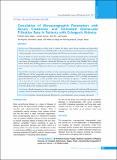Please use this identifier to cite or link to this item:
https://hdl.handle.net/20.500.14356/1306| Title: | Correlation of Ultrasonographic Parameters with Serum Creatinine and Estimated Glomerular Filtration Rate in Patients with Echogenic Kidneys |
| Authors: | Gupta, Prashant Kumar Kunwar, Laxman BC, Bom Gupta, Aarti |
| Citation: | GuptaP. K., KunwarL., BCB., & GuptaA. (2020). Correlation of Ultrasonographic Parameters with Serum Creatinine and Estimated Glomerular Filtration Rate in Patients with Echogenic Kidneys. Journal of Nepal Health Research Council, 18(3), 495-499. https://doi.org/10.33314/jnhrc.v18i3.2760 |
| Issue Date: | 2020 |
| Publisher: | Nepal Health Research Council |
| Article Type: | Original Article |
| Keywords: | Correlation Estimated glomerular filtration rate Renal echogenicity Serum creatinine Ultrasound |
| Series/Report no.: | Jul-Sep 2020; |
| Abstract: | Abstract Background: Ultrasonography is widely used to evaluate the kidney status. Serum creatinine and glomerular filtration rate assess the functional status of the kidney. This study tried to find the association between renal parameters in ultrasonography, serum creatinine and estimated glomerular filtration rate in patients with echogenic kidneys. Methods: Study was done in 61 patients. Four sonographic renal parameters (renal echogenicity grade, renal length, cortical thickness, parenchymal thickness) were obtained from patients showing echogenic kidneys irrespective of cause during ultrasonography of abdomen. Glomerular filtration rate was calculated using Modified Diet in Renal Disease formula after obtaining patient’s serum creatinine level. Sonographic renal parameters were compared with serum creatinine and estimated glomerular filtration rate using Pearson’s correlation coefficient and one-way ANOVA tests. Results: The study showed significant correlation of only renal echogenicity grade and parenchymal thickness with eGFR. However, all four sonographic renal parameters showed significant correlation with serum creatinine level. Renal echogenicity grading had strongest correlation with both serum creatinine (r=0.571, p=0.000) and estimated glomerular filtration rate (r= -0.349, p=0.006). Mean serum creatinine (in mg/dL) ± standard deviation was 1.9(±1.5), 4.0(±3.7), 5.8(±3.7), and 15.4(±5.3) for grade I, II, III, and IV echogenic kidneys respectively. Similarly, mean eGFR (in ml/min/1.73m2) ± standard deviation was 50.2(±22.9), 35.9(±40), 15.7(±13.4), and 3.4(±1.1) for Grade I, II, III, and IV echogenic kidneys respectively. Conclusions: Renal echogenicity is a better sonographic parameter that correlated well with both eGFR and serum creatinine. Renal ultrasound should be routinely used for early diagnosis, grading and monitoring of kidney disease. Keywords: Correlation; estimated glomerular filtration rate; renal echogenicity; serum creatinine; ultrasound |
| Description: | Original Article |
| URI: | http://103.69.126.140:8080/handle/20.500.14356/1306 |
| ISSN: | Print ISSN: 1727-5482; Online ISSN: 1999-6217 |
| Appears in Collections: | Vol. 18 No. 3 (2020): Vol. 18 No. 3 Issue 48 Jul-Sep 2020 |
Files in This Item:
| File | Description | Size | Format | |
|---|---|---|---|---|
| 2760-Manuscript-18848-1-10-20201115.pdf | Fulltext Article. | 198.53 kB | Adobe PDF |  View/Open |
Items in DSpace are protected by copyright, with all rights reserved, unless otherwise indicated.
